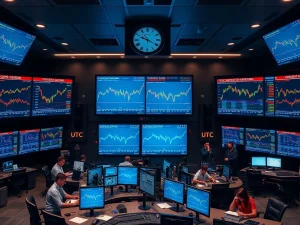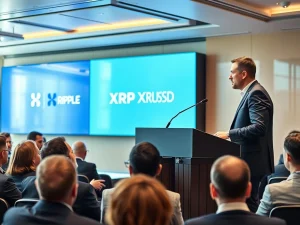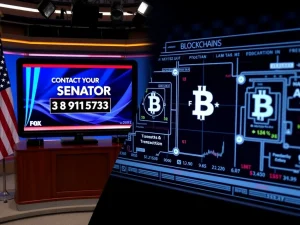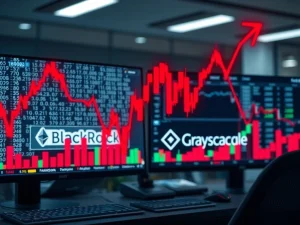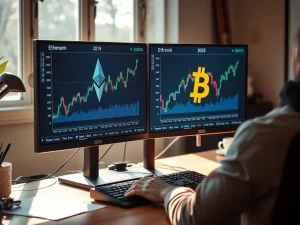Bitcoin Skyrockets: Potential US-China Tariff Truce Ignites Crypto Market Optimism
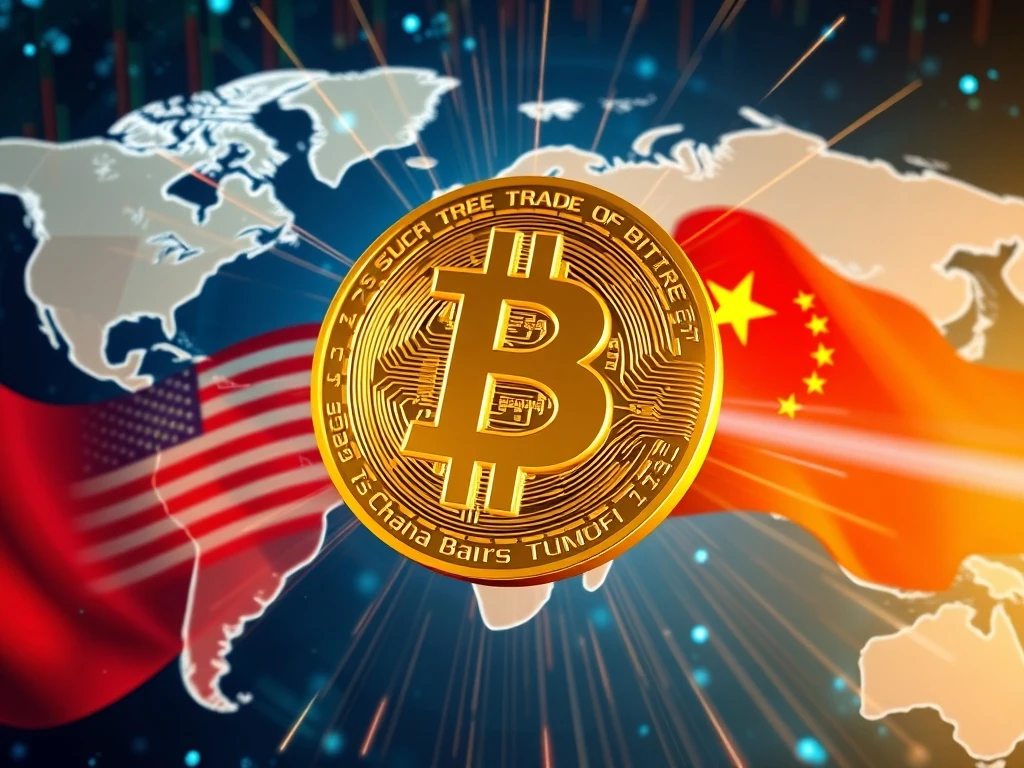
Bitcoin, the world’s leading cryptocurrency, has once again demonstrated its profound sensitivity to global economic shifts, soaring nearly 2% amid promising, albeit unconfirmed, reports of a potential 90-day US-China tariff truce. This significant price movement, pushing Bitcoin past the $119,000 mark, has injected a palpable sense of optimism into the broader crypto market, leaving investors eager for official confirmation.
What’s Driving Bitcoin’s Latest Surge?
The recent surge in Bitcoin‘s value can be directly attributed to speculative news regarding a temporary de-escalation in trade tensions between the United States and China. Reports indicate that U.S. Treasury Secretary Scott Bessent and Chinese Vice Premier He Lifeng have engaged in discussions, hinting at the possibility of a broader economic partnership. While no official joint statement has been released, the whispers of a 90-day extension to existing tariff pauses—initially discussed during trade talks in Stockholm—have been enough to trigger a ‘risk-on’ sentiment across global financial markets.
This potential truce, if finalized, would provide both economic superpowers with an additional three months to iron out complex trade disputes. The immediate impact has been a noticeable shift in investor behavior, with capital flowing towards higher-risk opportunities, including cryptocurrencies and equities, and away from traditional safe-haven assets like gold. The global crypto market cap has responded in kind, reportedly nearing the $4 trillion mark, reflecting renewed confidence.
Understanding the US-China Tariff Truce: A Breath of Fresh Air for Risk Assets?
The prospect of a US-China tariff truce is a significant development, as easing tensions between the world’s two largest economies often translates into short-term gains for risk assets. Historically, periods of reduced geopolitical friction have encouraged investors to seek higher returns in more volatile markets. Bitcoin, in particular, has shown a remarkable correlation with such shifts, often acting as a bellwether for investor sentiment regarding global economic stability.
The proposed 90-day extension aims to create a window for more substantive negotiations, allowing both nations to address core disagreements without the immediate pressure of escalating tariffs. This temporary reprieve is viewed positively because it reduces uncertainty, a major deterrent for investment. For the crypto market, which thrives on liquidity and positive sentiment, any news that signals greater global stability is generally met with an upward price trajectory.
Historical Precedent: Geopolitical Stability and Crypto Performance
To truly appreciate the current rally, it’s essential to look at historical patterns. Bitcoin‘s performance during previous trade negotiations or periods of heightened geopolitical tension offers valuable insights. For instance, during earlier phases of trade discussions, Bitcoin has often exhibited volatility, reacting sharply to both positive and negative news. When geopolitical stability appeared to improve, investors tended to reallocate capital from less volatile assets to more speculative ones like cryptocurrencies.
Conversely, periods of increased uncertainty, such as the early days of the pandemic or previous trade escalations, have also seen Bitcoin‘s price fluctuate wildly, sometimes acting as a safe haven and other times mirroring the broader market’s decline. This current scenario, however, seems to lean towards the ‘risk-on’ side, with the potential truce signaling a temporary easing of the pressures that often drive investors to seek safety. This demonstrates Bitcoin’s evolving role as a complex asset influenced by a myriad of macroeconomic factors.
Navigating the Volatility: What Investors Need to Know About the Crypto Market
While the current rally is exciting, experts caution that the enthusiasm remains largely speculative. The absence of official confirmation for the US-China tariff truce means that the market’s gains are built on unverified reports, which can amplify crypto market volatility. Unresolved issues, such as intellectual property protections, forced technology transfers, and persistent trade imbalances, are deep-seated structural challenges that a mere 90-day pause cannot fully address. A durable agreement will require far more than a temporary ceasefire.
Investors should also consider broader economic pressures. The U.S. and China face a critical deadline by August 12 to finalize any agreement. Furthermore, other geopolitical developments, such as a 15% tariff on EU goods and pending semiconductor import investigations, could divert attention and resources away from the China negotiations. Market observers note that while Bitcoin‘s recent gains reflect growing institutional interest in digital assets as a hedge against macroeconomic uncertainties, prudence is paramount. Traders are advised to exercise caution, as unverified news can lead to rapid price reversals.
Bitcoin’s Trajectory: A Barometer for Global Policy Shifts
Bitcoin‘s recent trajectory underscores its growing role as a barometer for global economic policy shifts. Its performance is increasingly tied to major geopolitical developments, reflecting the interconnectedness of global policy and digital asset valuations. The outcome of the Stockholm talks, and whether the US-China tariff truce is officially confirmed, will not only shape Bitcoin‘s immediate performance but also broader economic dynamics, given the immense scale of U.S.-China trade volumes.
As of the latest reports, a joint statement confirming the extension has not been issued by either the U.S. or China. Investors are strongly urged to remain cautious and monitor official announcements. The 90-day timeline aligns with broader U.S. trade strategies that aim to balance de-escalation with long-term pressure for concessions. While the crypto market‘s reaction highlights its sensitivity to global events, the structural challenges in trade negotiations may temper long-term gains if a more comprehensive and durable agreement is not reached.
In conclusion, the recent surge in Bitcoin‘s price driven by the potential US-China tariff truce is a compelling reminder of how intertwined the world of digital assets has become with traditional geopolitical and macroeconomic forces. While the optimism is understandable, the speculative nature of the rally demands caution. The coming weeks will be crucial as markets await official confirmation, which will undoubtedly determine whether this exciting jump is a foundation for sustained growth or merely a temporary fluctuation in the ever-dynamic crypto market.
Frequently Asked Questions (FAQs)
1. What caused Bitcoin’s recent price surge?
Bitcoin’s recent nearly 2% price jump was primarily driven by unconfirmed reports of a potential 90-day tariff truce between the United States and China, sparking optimism and a ‘risk-on’ sentiment in global markets.
2. What is the significance of the potential US-China tariff truce for the crypto market?
A potential US-China tariff truce signals easing geopolitical tensions, which historically leads to increased investor confidence in risk assets like cryptocurrencies. It reduces economic uncertainty, encouraging capital flow into the crypto market.
3. How has Bitcoin historically reacted to geopolitical events?
Bitcoin has often acted as a barometer for geopolitical stability. During periods of de-escalation or positive trade news, it tends to see gains as investors shift from safe-havens to higher-risk opportunities. Conversely, increased uncertainty can lead to volatility.
4. Is this Bitcoin rally sustainable?
Experts caution that the current rally is speculative, as it’s based on unconfirmed reports. The sustainability depends on official confirmation of the truce and progress on deeper, unresolved trade issues like intellectual property and trade imbalances. Investors should remain cautious.
5. What are the key risks associated with this news for crypto investors?
The primary risks include the unverified nature of the news, which can lead to rapid price reversals. Additionally, broader economic pressures and the potential for the truce to fall through or not lead to a durable agreement pose risks to the crypto market’s current gains.
6. When can we expect official confirmation of the tariff truce?
As of the latest reports, neither the U.S. nor China has issued a joint statement confirming the extension. Investors are urged to monitor official announcements closely, as the critical deadline for finalizing an agreement is August 12.

